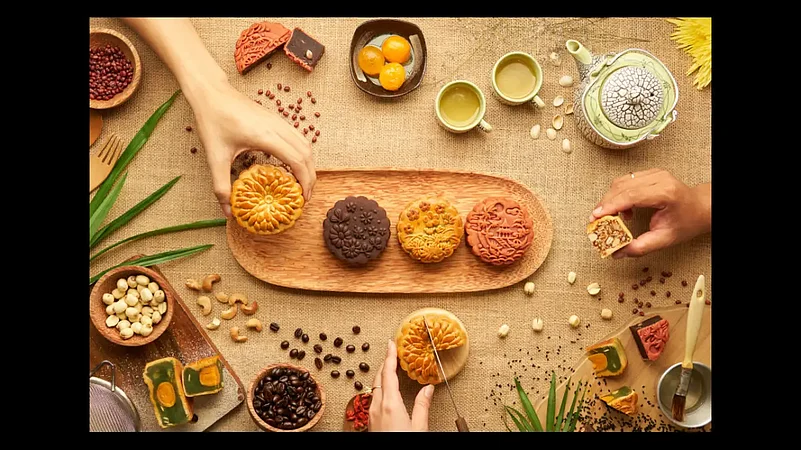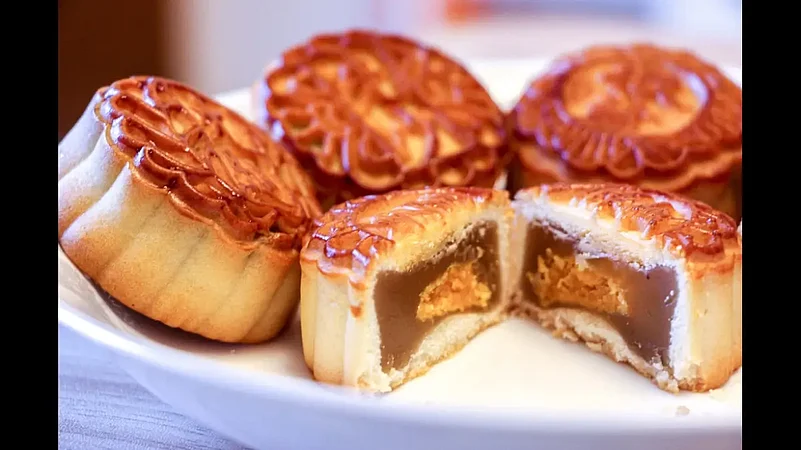A few years back, the image of a lovely designer cake on a digital media post caught my attention. It was a mooncake and it was being made by a Chinese chef in Kolkata.
But what was a mooncake, I wondered?

Which made me turn to Robert Hsu, a young member of the Indian Chinese Association who I had met earlier in the year during a walk through India’s oldest China Town sprawling across Tiretta Bazaar neighbourhood in central Kolkata.
“It is part of the Moon Festival, which is the second most popular festival for the Chinese next to the New Year,” said Robert Hsu, “but not many people know about this because it is mostly celebrated within the family.” Robert Hsu’s family is one of the few ethnic Chinese Indian families who still call Kolkata home.
The Moon Festival, also known as the Mid Autumn Festival, observed on the 15th day of the eighth Lunar month of the Chinese calendar, is rooted in legends and made popular by a political aspiration in the 14th century. This year, the Moon Festival is on September 10.
According to the legend, one mid-autumn night, Chang Er, tired of being stuck on earth as her husband – archer Hong Yi – refused to leave for heaven, stole the ‘immortality pill’ from him and floated to the moon. It was so sudden that she could only snatch up her pet jade rabbit. Ever since, they have been trying to concoct a pill that would get them back to earth. Since then, their shadows are visible on that particular day.
According to Chinese custom, on this day, families get together to celebrate the Mid-Autumn Festival (Chung Chou Chi), which consists of ‘moon viewing’, and eating moon cakes, fruits, shell boiled groundnuts, and green tea. According to Hsu, pomelo is the preferred fruit.
It is said that in the 14th century, people who had risen as rebels against the Mongol rule, found an innovative way to exchange messages – by hiding them inside moon cakes. When the Mongols were overthrown and the Ming dynasty of the Han people came to power, the tradition of sharing moon cakes with family and friends continued.
Moon cakes are also offered as a mark of respect to senior members of the community as well as an offering to the spirit of the ancestors.
According to Hsu, buying moon cakes is a recent phenomenon because earlier it used to be made by the family members.
His views were reiterated byJanice Lee, a fourth generation Indian-Chinese born and brought up in Kolkata (the famous Pou Chong Sauces was founded by her grandfather).
In her household too there was a long tradition of baking of mooncakes, with ther grandmother in charge. "it was a lot of fun growing up with this tradition of the moon festival," said Lee. "We also baked these delicious cookies that came in the shape of a moon or small gingerbread type man shapes," she said, "in addition to the mooncakes which had salted duck eggs and red beans paste inside."
Chef Alex Li, also from Kolkata, and who had baked that awesome looking mooncake, reiterated Hsu’s feeling. “I cherish the memories of my mother making the moon cakes while all the siblings helped out in the kitchen,” said Li. “The Moon Festival is about togetherness and keeping alive the tradition and techniques of making the cakes.”
Another popular ritual was making lanterns. Much to Hsu’s regret, the custom of lantern making has almost died. Even a few years back, the Association would hold lantern parades. Children would make these paper lanterns, often as part of a competition. Apart from the paper lanterns, there would be lanterns in the shape of rabbits, fish, aeroplanes, etc. Recalled Lee, "As children we used to light up the lanterns which in Hakka was called Tung-Lung." Groups of children would carry a lantern each, which had a stick attached to it ,and roam the entire neighbourhood and even visit neighbours' homes.. "The belief was that we blessed each house and drove away bad spirits or energy." she said.

According to Chef Li, there are two versions of moon cakes. “One, in which the pastry skin is baked. And the Snow Skin, which is not baked,” he said. There are different kinds of fillings that go into these cakes, such as lotus paste, red beans, yam, roasted five nuts, and salted duck eggs. The lotus paste usually goes with the Snow Skin. “In Kolkata, the pastry skin with red beans and five nuts are the best sellers,” said Li. “These happen to be my favourites too,” he added with a smile.
With the number of long-settled Chinese families of Kolkata dwindling fast, moon cakes may soon be a thing of the past too. So go ahead and buy a few while they are still being baked. Usually, mooncakes are sold at the weekly Sunday Chinese Breafast Market as the festival approaches. Some of the Chinese cafes in the city have also started baking them. Tangra based Kitchen 86 said they are accepting pre-orders for mooncakes now.
















